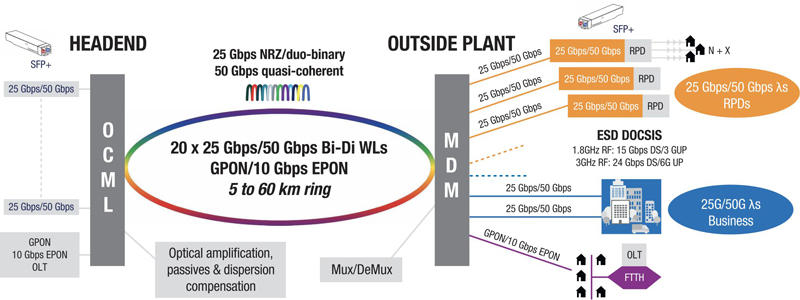Emerging Optical Access Technologies for 10 Gbps + Internet
By Harj Ghuman
Cable operators are investigating how access networks can deliver 10 Gbps Internet and perhaps as much as 20 Gbps in the next 10 to 20 years to meet demand generated by 4K, Internet of Things (IOT), virtual/mixed/augmented (VR/MR/AR) reality and other applications. As cable operators migrate to distributed access architectures (DAA), optical links to remote PHY device (RPD) equipped shelves and nodes need to be scaled from 10 Gbps and beyond in the future. Coherent detection has been revolutionary in transforming the optical core and metro landscape and is able to provide data rates exceeding 400 Gbps per wavelength. However, direct detection is becoming the de-facto standard for metro data center interconnect (DCI) and optical access. Emerging optical technologies like quasi-coherent and quantum dot lasers show great promise for high capacity 80 km edge networks. Intensity modulated direct detection (IM-DD) optical systems such as pulse amplitude modulation (PAM4), non-return to zero (NRZ), and duo-binary, create considerable use cases for access networks. IM-DD DWDM transceivers with data rates of 25 Gbps/50 Gbps bridge the wide-gap between 10 Gbps, direct detection and 100 Gbps + coherent systems offer a natural evolution and capacity expansion of current 10 Gbps DWDM access networks, allow operators to recoup existing ROI in deployed architectures, and create a potential convergence with 5G wireless networks. 25 Gbps optical links to RPDs plus extended spectrum DOCSIS (ESD), which extend the RF plant from 1.2 GHz to 1.8 GHz (or even 3 GHz and beyond), offer cable operators a path to provide > 10 Gbps Internet over an existing node + X environment. Low cost direct detection optics can provide these higher capacity 25 Gbps optics, but considerable technical challenges exist in developing >50 Gbps direct detection 80 km optics. 50 Gbps to 100 Gbps quasi-coherent optical transceivers are conceivable (though 100 Gbps is challenging) and could provide an attractive alternative or complement true 100 Gbps + coherent. Such devices have low latency, are simpler and lower cost with a reduced power consumption, making them desirable for access networks. The growing importance of low latency applications such as 5G, autonomous vehicles, virtual and augmented reality have spurned the search for 100 Gbps transmission alternatives that do not suffer from the excessive signal latency of today’s coherent transmission with its heavy use of digital signal processing (DSP) and forward error correction (FEC).
Optical detection and modulation schemes
Detection schemes can be broadly classified into three groups: direct, coherent and the emerging quasi-coherent or DSP-less variant of coherent. Modulation schemes used in direct detection and quasi-coherent solutions are NRZ, PAM4 and duo-binary, while full-fledged coherent utilizes QPSK and QAM plus dual polarizations.
Intensity modulated direct detect devices (IM-DD)
Common transceivers for access networks with bitrates of 1 Gbps/10 Gbps/25 Gbps use simple intensity modulation (transmitter side) and “direct detection” (receiver side), or IM-DD. It is also called “on/off keying” (OOK) or NRZ. It has been widely adopted and its main limitation is reach — the higher the bitrate, the shorter the reach due to chromatic dispersion (CD) and polarization mode dispersion (PMD). Duo-binary is a special OOK signal that is more resilient to dispersion than NRZ. PAM4 is increasingly being used for higher data rates because of the ease of using regular electronics and optical components suitable for small form factor such as QSFP28. A drastically reduced power consumption and low latency make it desirable for data center interconnect (DCI) applications. The main disadvantage of PAM4 modulation is that it requires amplification, dispersion compensation modules (DCM), and a high optical to signal noise ratio (OSNR). Low cost 100 Gbps transceivers with two wavelengths utilizing PAM4 modulation at 50 Gbps each are now available.
Quasi-coherent solutions
Quasi-coherent systems typically increase the receiver sensitivity more than 10 times over a conventional optical receiver and offer vast simplification over “full-blown” DSP coherent. Quasi-coherent receivers use a local oscillator (LO) to produce signal gain, but do not need to extract phase information, resulting in high sensitivity. Instead of using expensive DSP algorithms, these receivers utilize envelope detection for signal extraction. While the detection system may be classified as coherent, typically NRZ or PAM4 modulation is utilized for high capacity data rates at significantly lower cost and power consumption than full blown coherent devices. However, intensity modulation comes with its inherent dispersion challenges which must also be accounted for in quasi-coherent systems. Small form factors (SFP+ or QSFP 28) and high data rates (50 Gbps or higher) are realizable, making them perfect for access applications such as DAA. No DSP is required, only analog signal processing, hence very low power consumption and low latency are achievable. A 50 Gbps quasi-coherent optical link to a RPD + 6 GHz RF spectrum could deliver 50 Gbps Internet in fiber deep architectures. Another important consideration for many access networks is the ability of quasi-coherent solutions to transport different bi-directional wavelengths on the same fiber, without requiring a second laser as in full coherent systems.
Quantum dot multi wavelength laser
Quantum dot multi wavelength lasers (QD MWL) are semiconductor lasers capable of generating multiple wavelengths simultaneously from a single device. A single QD MWL can provide up to 96 wavelengths in the C-band alone, allowing for the replacement of 96 individual lasers in an equivalent system. QD MWL solutions allow for simple and compact interface design, low power consumption and better performance compared to an equivalent solution having multiple discrete lasers and components. A combination of QD MWL and silicon photonic devices is ideal for implementation of DSI and access networks. 200 Gbps direct detection transceivers with 80 km reach can be realized by combining several wavelengths of the QD MWL with appropriate amplification and dispersion compensation.
25 Gbps NRZ/duo-binary and 50 Gbps quasi — coherent + extended spectrum DOCSIS
Operators are investigating technology enablers for their 10G initiative and DAA architectures with 25 Gbps optical links to RPDs combined with an extended RF spectrum of 1.8 GHz provides a path to > 10 Gbps Internet. 10 Gbps NRZ direct detection has been widely deployed for access networks and Cox has begun R-PHY deployments using 10 Gbps NRZ DWDM optical access (Broadband Library Summer 2018 issue “OCML for Converged Access Networks”) and this infrastructure can be readily upgraded to transport 25 Gbps NRZ DWDM. There has been a lot of interest in 25 Gbps optics due to 5G wireless requirements, and 25 Gbps NRZ DWDM SFP+ transceivers are now available. These transceivers represent incremental technology from 10 Gbps optics at a slightly higher cost, but 2.5 times the capacity. One of the inherent issues with NRZ modulation is the increased dispersion at higher data rates which reduces distance, so DCMs must be deployed in the optical network. Duo-binary has better dispersion tolerance and could be an attractive alternative to conventional NRZ modulation. DAA using 25 Gbps optical links to RPDs combined with an extended RF spectrum of 1.8 GHz initially but eventually 3 GHz provide a path for >10 Gbps Internet serving 200 HHP in N + X architectures. Figure 1 shows a 25 Gbps/50 Gbps IM-DD DWDM optical access network which when combined with an RF spectrum of 1.8 GHz can retain a N + X cascade to provide >10 Gbps to a larger pocket of 200 homes. The advantage of using such an optical access network is that it affords a readily upgradeable way of providing more subscriber bandwidth. Additional 25 Gbps transceivers can be added when needed to reduce the number of homes per RPD. In addition to upgrading the outside plant, next generation RPDs will have to support 25 Gbps optics with its higher power and heat dissipation requirements. This network could also be upgraded to a 50 Gbps DWDM direct detect quasi-coherent optical network, which combined with a 6 GHz RF spectrum could realize 50 Gbps Internet.

Figure 1. 25 Gbps/50 Gbps IM-DD DWDM + PON access network
Conclusion
The insatiable demand for ever-increasing subscriber bandwidth is fueling the move from 10 Gbps to 25 Gbps and eventually 50 Gbps access networks. Direct detection and emerging optical technologies such as quasi-coherent and quantum dot multi wavelength lasers provide attractive solutions for low latency, cost effective optical transport, with a low carbon footprint. 25 Gbps NRZ/duo-binary and 50 Gbps quasi-coherent DWDM optics + extended spectrum DOCSIS in DAA architectures offer a scalable solution for cable operators to provide > 10 Gbps Internet in Node + X environments and further extend the life of the ever resilient and flexible HFC network.
 Harj Ghuman
Harj Ghuman
Principal Engineer,
Cox Communications
Harj Ghuman is a Principal Engineer at Cox Communications, primarily focused on optical access architectures. He holds an M.S. degree in modern optics and microwaves and is recognized as a subject matter expert in fiber optics and millimeter wave (MMW) technologies. He has been instrumental in developing the patented concept of the OCML/MDM architecture for use in Cox’s remote PHY architecture. He holds several patents and has authored numerous technical papers.


